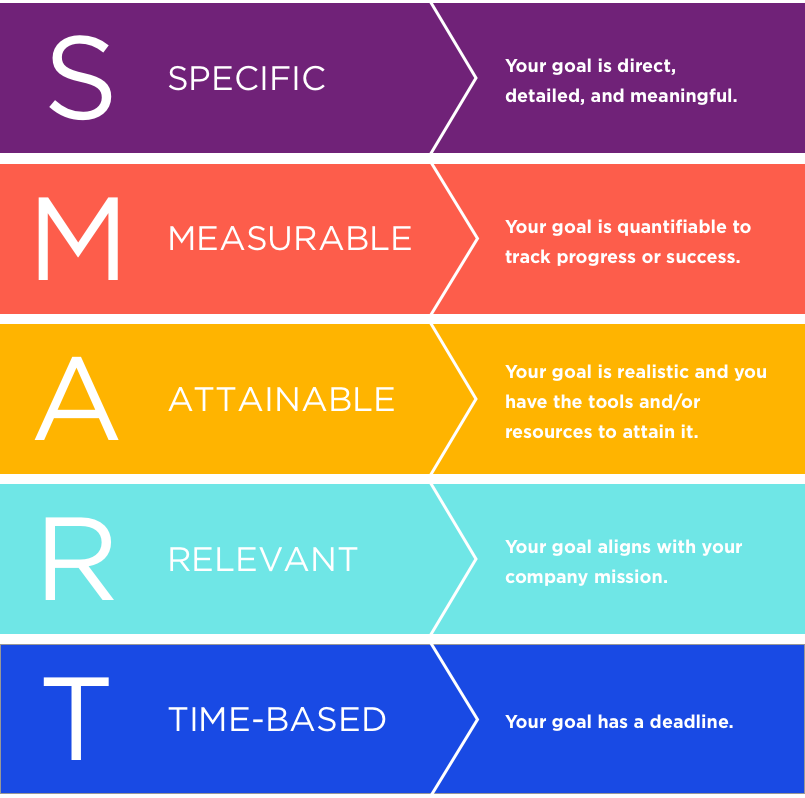Goal-setting is the bedrock to any successful marketing strategy. In fact, in a study by CoSchedule, marketers that set goals are 376% more likely to report success in their work.

Of course, it’s not so much about goal-setting as it is about setting good goals. That is, you need to set appropriate, clearly defined goals in order to see tangible results. A goal is meaningless if it’s vague, irrelevant, or simply unmeasurable.
For SaaS businesses, strategic goal-setting is especially crucial for finding long-term success, as 92% of SaaS startups fail within three years of launching. To keep your company on a steady trajectory, you’ll want to clearly pinpoint and define your marketing priorities. 🏁
What are common SaaS marketing goals?
The Oxford English Dictionary defines marketing simply as “the action or business of promoting and selling products or services.”

Sure, boiled down to its core, marketing revolves around promoting and selling, but you can also think of these activities in more nuanced subcategories. When it comes to goal-setting for your marketing team, you’ll want to focus specifically on these five objectives:
- Brand awareness
- Thought leadership
- Loyalty and customer retention
- Customer engagement
- Lead generation
A well-rounded and cohesive marketing strategy incorporates targets for each of these pillars, often with some overlap in metrics. 📊 For example, increasing organic traffic to your SaaS brand’s website is relevant to both brand awareness and lead generation. This overlap doesn’t mean you should aim for fewer goals, however.
Rather, it’s important to recognize that your metrics are multifaceted and can represent performance on more than one front. Below, we’ll dive into each of these broader marketing goals and the key performance indicators (KPIs) best suited to measuring them.
SaaS Marketing Goals & KPIs
Brand Awareness 👁️
Brand awareness is considered one of the most important yet obscure goals of marketers, largely because there is no straightforward method of quantifying it. Setting goals for this purpose means enhancing your brand’s potential to be seen—and perhaps more importantly, recognized—by leads.

Improving brand awareness can occur in several ways, but according to a 2020 B2B marketing report by Content Marketing Institute and MarketingProfs, the top three methods marketers agreed on were: blog posts/short articles, social media content, and in-person events.
Relevant KPIs:
- Direct traffic
- Social engagement
- Earned media
- Backlinks (referral traffic)
- Search volume for your SaaS brand
Thought Leadership 🧠
Now that you’ve been seen, you’ll want to be heard. Thought leadership is exactly that—it involves positioning your brand as an authority. Whereas brand awareness focuses on brand recall and recognition, thought leadership establishes your brand’s presence and expertise.
You can develop your SaaS business’s reputation as a thought leader in its industry by taking an educational approach to your marketing. Focus on delivering valuable insight, e.g., through white papers and ebooks, rather than publishing widely known or easily accessible information. 📚
Relevant KPIs:
- Site traffic
- Social media following
- Earned media
- Backlinks (referral traffic) 🔗
Loyalty & Retention 😍
Brand loyalty is critical for SaaS companies, especially given their subscription-based business model. In fact, according to a 2019 study by Yotpo, 59% of loyal customers are more than willing to refer a brand to their friends and family. What’s more, 36% prefer to spend more on a brand they feel loyalty toward instead of opting for a cheaper alternative.

But how do you cultivate customer loyalty? Broadly, marketing focused on this objective involves developing customer-brand relationships. It often takes the form of producing reliable and trustworthy content, like newsletters, case studies, and blog posts.
Relevant KPIs:
- Customer churn
- Monthly recurring revenue
- Revenue churn
- Lifetime value
Customer Engagement 👋
Not to be confused with loyalty, customer engagement describes the interaction between your brand and its customers throughout their lifecycle. 💬 Highly engaged customers have major ramifications for your company’s longevity: according to a study by Hall and Partners, as much as two-thirds of a company’s profits rely on solid customer engagement.
For this reason, creating a customer-centered experience is crucial to SaaS brands. To better engage customers, you’ll need to get close to your target audience. Ask for their honest feedback, even if it’s negative. Then adapt your service, onboarding program, communication—whatever it is—accordingly.
Relevant KPIs:
- Daily usage
- Customer churn
- Renewal rate
- Net promoter score
- Customer satisfaction
Lead Generation 🤝
There’s no surprise why lead generation constitutes a marketing priority. This straightforward objective is tied to your SaaS brand’s bottom line—but you’ll want to look at more than just conversion rate. For instance, perhaps your SaaS business already attracts a decent number of prospects, but you’d like to improve lead quality.
Whatever the nature of your goals, there are plenty of lead generation strategies: creating gated content, hosting webinars and events, and offering a free trial, to name a few.
Relevant KPIs:
- Conversion rate
- Customer acquisition cost
- Customer lifetime value
- Customer conversion ratio by source
- Annual recurring revenue
- Average deal size
5 Best Practices for Setting (& Crushing) Your SaaS Marketing Goals
Ready to ramp up your SaaS marketing strategy? Follow these best practices to set more meaningful goals—and crush them.
1. Follow the “SMART” acronym.
In case you’re not already familiar with it, the “SMART” acronym outlines five attributes to guide individuals toward making clear and reachable goals:

For those who are prone to setting overambitious targets, the SMART acronym provides a helpful framework for staying grounded. It also helps to clarify goals for marketers with only a hazy vision of what they want to achieve. For instance, it’s not enough to simply aim for “increasing traffic” or “generating more leads.” Instead, SaaS marketers should create more detailed goals like “Increase organic traffic to my SaaS brand by 10% within six months.” 📈
2. Think both short- and long-term.
As you set marketing goals for your SaaS company, remember to keep sight of both the big picture and micro-level details. In other words, come up with a variety of short- and long-term goals. 🕰️
Focusing on just one type can take away from your overall strategy by making it shortsighted or seem unattainable. For instance, setting only short-term objectives often results in a meandering and scattershot approach to marketing, with no real end game in sight.
3. Set regular benchmarks for long-term goals.
Yes—it’s important to set both short- and long-term goals. However, the motivation to conquer a goal that’s a year (or longer!) away doesn’t always come easily.
To generate momentum with these long-term marketing goals, break them down into more digestible pursuits. 🚩 For example, if you’ve got a year-long goal, set monthly or quarterly benchmarks. Establishing these smaller goalposts will help you stay on track and prevent you from losing sight of what may otherwise be a distant or overwhelming target.
4. Analyze the market as well as your brand’s past performance.
If you’re struggling to identify your top marketing priorities, consider looking to your competitors as well as your brand’s own track record for some inspiration. 🕵️
Difficult as it may be, position yourself as an objective outsider. Then examine your industry rivals’ work compared to yours. Make note of your brand’s successes and then dive deep into its failures.

Consider:
- What are your competitors doing that you aren’t?
- Can you identify any gaps in your competitors’ strategies? 🔍
- Has your customer base changed or fluctuated in the past year? If so, what was the nature of these changes?
- What were the biggest shortcomings of your previous marketing campaigns?
Craft goals based around these observations. For instance, if you see that your competitor doesn’t offer much in the way of email marketing or thought leadership, create a new monthly newsletter for reporting SaaS industry news.
5. Focus on the process, not the outcome.
Finally, remember that your marketing goals are worthwhile pursuits—but achieving them isn’t the only measure of success for your brand. There’s an intrinsic value to striving and working hard even if the end result isn’t what you wanted.
In other words, there’s more to gain from a goal than simply accomplishing it. Be cognizant of the learning opportunities along the way. 🗺️ 📍
You may even find that your initial goals aren’t right for your business. Whether it’s because of a change in your business strategy, or new product or customer insight, course correction is inevitable—and it’s perfectly fine.
Major Takeaways
Setting meaningful and strategic goals for your SaaS business matters for creating a sustainable growth plan. Without realistic or concrete objectives to aim for—or the right KPIs—your marketing risks being jumbled and haphazard.
Of course, it’s not enough to just set a goal. You need practical targets that align with your brand’s mission and audience’s needs. Setting these kinds of goals will ultimately lay the foundation for a more thoughtful and effective marketing strategy.






